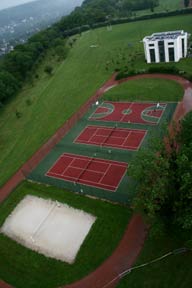You may have been involved in a such a debate – whether your local government should invest in local sports facilities – perhaps to be housed on your school property.
While it didn’t involve school property, my hometown has just been involved in such a political donnybrook. Our mayor, in my mind a forward-looking politician, proposed a multi-use sports facility and performing arts centre for our city of 155,000. This proposal raised the ire of a very vocal group (many of whom are retired citizens who spend their spare hours writing letters to the editor), who want all public monies spent on smoothing the potholes out of local roads.
The arguments of this vocal opposition was that spending money on recreational facilities is a frill, whereas infrastructure spending is a necessity. And of course, the new sports facility would result in an temporary levy in taxes.
It’s the typical argument of the ill-informed…the same type of people responsible for declaring physical education to be a frill subject.
In fact, the opposite is the case. Physical education and the provision of facilities that encourage physical activity are anything but frills. The western world is in the midst of a childhood obesity crisis – a crisis that will result in an astronomical increase in health care costs in the next decade or two. In publicly funded health care systems, like Canada’s, Great Britain’s, and even America’s Medicare, that cost is borne by the taxpayer.
And that cost greatly outweighs the cost of prevention investments such as multi-use sports facilities and qualified physical education teachers.
Is this simple speculation? Absolutely not. A 2004 Queen’s University study has estimated the Canadian cost of inactivity and obesity (in 2001) to be 9.7 billion dollars!! In the U.S., in the year 2000, the cost of obesity alone was pegged at 117 billion! It is estimated that the direct medical costs in the U.S., of individuals aged 15 and older, are $330 more per person for those who are physically inactive versus physically active people – multiply that by every person in the country!!
The World Health Organization has stated that investment in sport (time, equipment and facilities) will yield three times that investment in medical cost savings. Any canny investor, seeing a 300% potential profit, would jump on that investment.
The outcome of the debate in my hometown? The pothole people won. Their victory will save them some municipal tax dollars, but it will cost them more in provincial health care taxes. A shallow victory indeed!
References:
1. A summary sheet on the WHO/CDC Workshop on Economic Benefits of Physical Activity / Burden of Inactivity, Ashville, USA, 18-22 July 1998.; http://www.who.int/hpr/physactiv/docs/health_and_development.pdf
2. P.T. Katzmarzyk & I. Janssen, “The economic costs associated with physical inactivity and obesity in Canada: an update.” The Canadian Journal of Applied Physiology, February 2004.
3. Michael Pratt, M.D ., et al. “Higher Direct Medical Costs Associated With Physical Inactivity.” The Physician and Sportsmedicine 28(10).Oct 2000.
4. Quantifying the Cost of Physical Inactivity, East Carolina University Department of Health Education and Promotion, 2006. http://www.ecu.edu/picostcalc/
5. A.M. Wolf, JE Manson, G.A. Colditz, “The Economic Impact of Overweight, Obesity and Weight Loss. In Eckel R, ed., Obesity Mechanisms and Clinical Management.” Lippincott, Williams and Wilkins, 2002.
6. World Health Organization, 2003; Health and Development through Physical Activity and Sport.
Dick Moss, Editor,
PE Update.com
To subscribe to the free PE Tips of the Week Newsletter, Click Here!
To check out the PE Update.com website, Click Here!
[tags]physical education,inactivity costs,sports facilities,tax savings[/tags]







